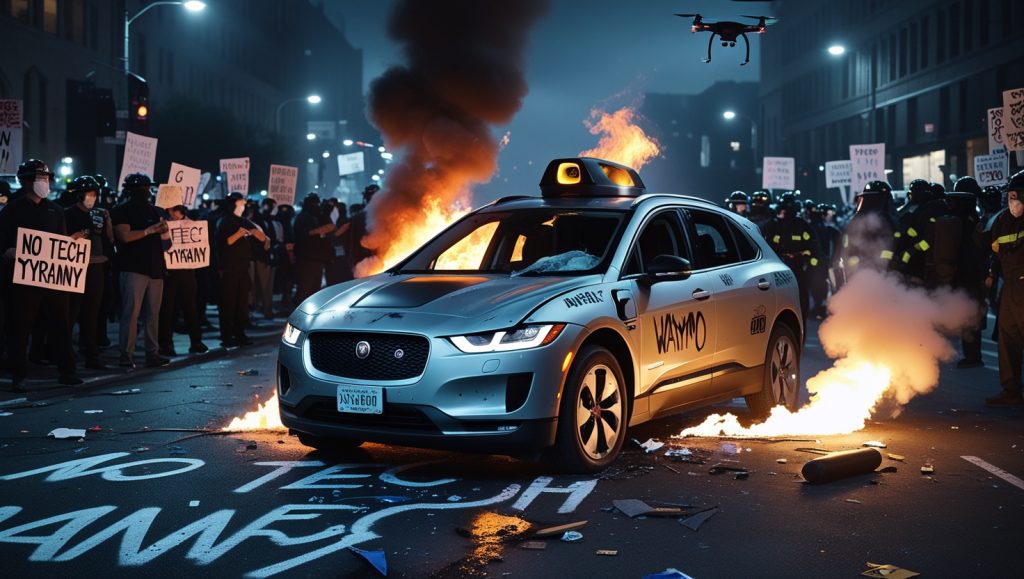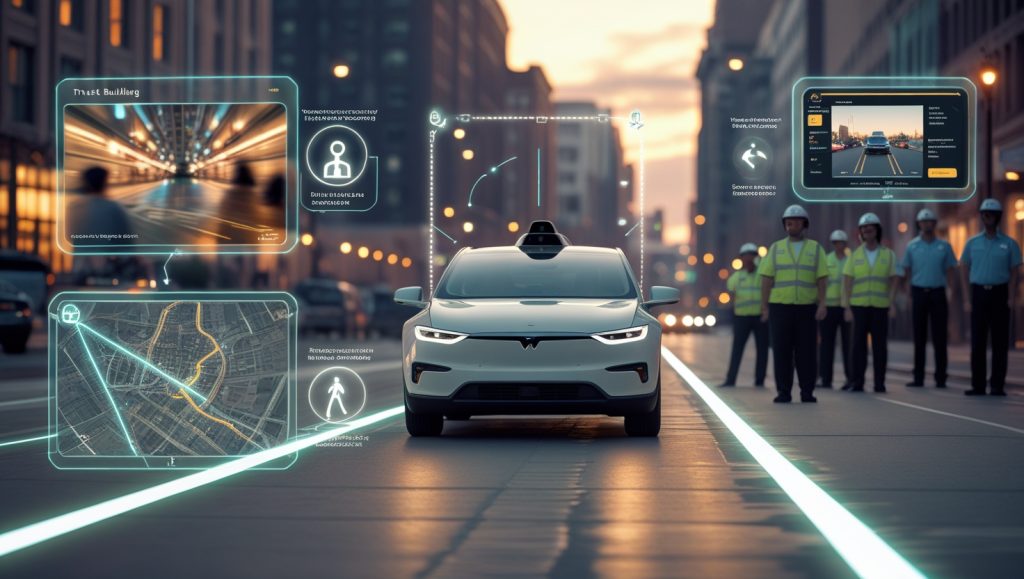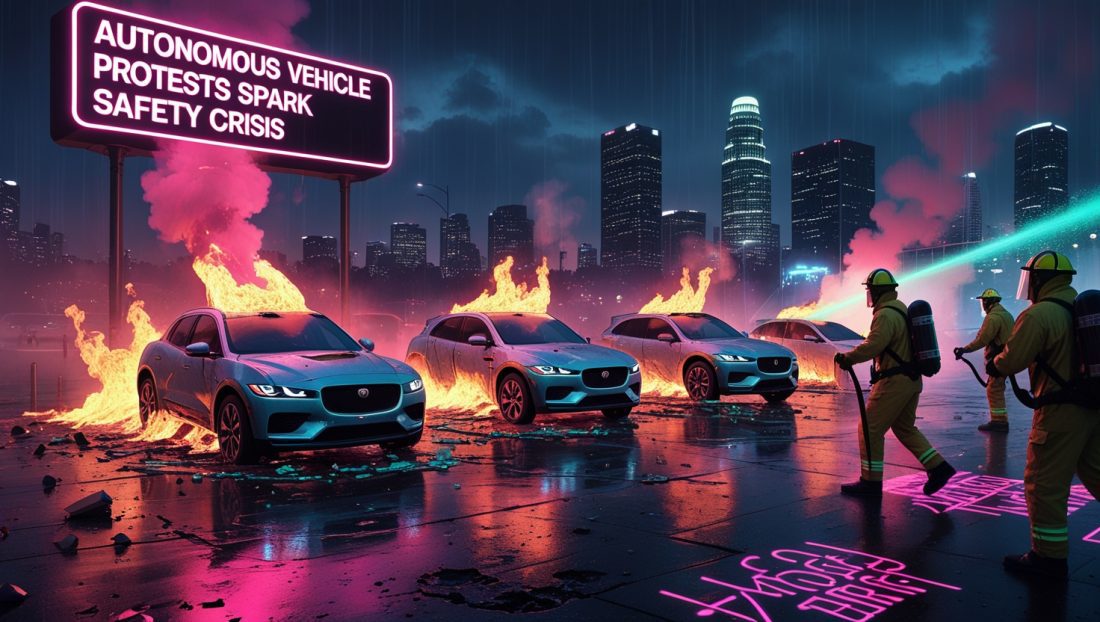The acrid scent of melting alloy hung heavy over downtown Los Angeles on June 8, 2025, as protesters dragged electric scooters into the hollowed shells of five flaming Waymo robotaxis. Plumes of toxic smoke billowed skyward—accidental casualties of autonomous vehicle protests against federal immigration raids that vaporized $1 million worth of technology and exposed fundamental flaws in autonomous vehicle deployment. This incident transcends vandalism; it represents a robotaxi safety crisis where engineering prowess collided violently with social distrust.
The Incident: Anatomy of Technological Vulnerability

When protests erupted against ICE raids and the unauthorized deployment of National Guard troops, Waymo’s vehicles became unlikely targets. Eyewitness accounts reveal a calculated sequence:
- Protesters spray-painted “NO TECH TYRANNY” on Jaguar I-Paces before ignition, explicitly referencing the vehicles’ 29-camera surveillance capabilities.
- Unlike human-driven taxis, the immobilized robotaxis couldn’t flee when surrounded. Evidence suggests at least one vehicle was summoned to the protest zone before being disabled.
- Firefighters battled lithium-ion battery fires for hours, releasing hydrogen fluoride gases capable of causing pulmonary damage within minutes of exposure.
Why Did Autonomous Vehicle Protests Become Focal Points?
The answer lies in their dual identity: mobility solutions and mobile surveillance platforms. In April 2025, LAPD used footage from a Waymo vehicle to investigate a hit-and-run—a precedent that transformed robotaxis into symbols of state surveillance.
This perception aligns with broader concerns about autonomous vehicle surveillance risks, where communities fear their movements are tracked without consent. For a deeper dive into how surveillance fuels distrust in robotics, explore why humanoid robots creep us out and how close they are to becoming unsettlingly real.
The Safety Paradox: When Data Conflicts With Reality
Waymo correctly cites its 92% reduction in injury crashes compared to human drivers. Yet this statistical advantage unraveled during civil unrest:
Table: The Robotaxi Perception Gap
| Metric | Waymo’s Data | Public Reality |
|---|---|---|
| Surveillance Transparency | “Limited data sharing” | LAPD accessed footage for criminal cases |
| Civil Unrest Response | Geofencing protocols | Summoned to protest zones, immobilized |
| Toxicity Risk | Battery safety certifications | Hydrogen fluoride levels reaching 450ppm during fires |
| Cybersecurity | Encrypted data protocols | Public fears of hacking and data misuse |
Why Does the Perception Gap Persist?
Despite robust safety data, public trust falters when robotaxis are perceived as tools of control rather than convenience. This gap widens with autonomous vehicle public distrust, as communities question who controls the data. Cybersecurity expert Dr. Elena Rossi notes: “These vehicles don’t just navigate streets—they archive public spaces. When communities perceive surveillance without consent, destruction becomes digital dissent.”
For insights into how AI-driven surveillance shapes global tech debates, see why China’s robot cops patrol and what’s next. Additionally, a 2025 study by the Electronic Frontier Foundation highlights how unclear data-sharing policies erode trust, amplifying calls for transparency.
Thermal Runaway: When Chemistry Becomes Combustion

The violent disintegration of Waymo’s batteries reveals terrifying physics. During thermal runaway:
- Individual battery cells exceed 1,000°C, triggering chain reactions in neighboring cells.
- Aluminum underbodies liquefy at 660°C, collapsing vehicle structures.
- Magnesium components flare white-hot, accelerating combustion.
- Hydrogen fluoride gas sears lung tissue, with concentrations fatal at 170ppm.
Why Are Robotaxi Fires So Hard to Contain?
The chemical intensity of lithium-ion battery fires poses unique challenges. Fire Captain Lisa Nguyen (LAFD) confirms: “Extinguishing each blaze required 40,000 gallons of water—40 times more than gasoline fires. Our hazmat teams weren’t equipped for this scale of EV toxicity.” This underscores the electric vehicle fire hazards that municipalities are unprepared for.
A report by the National Fire Protection Association notes that EV fires require specialized training and equipment, which most fire departments lack. For more on how robotics faces physical vulnerabilities, check why self-healing robotics might be the most critical innovation.
Techlash Economics: The $1 Million Catalyst
Each incinerated Jaguar I-PACE represented $150,000–200,000 in losses, but the financial impact pales against the robotaxi credibility crisis:
- Labor Displacement Fears: “NO DRIVERS, NO PEACE” graffiti on burning chassis echoed Teamsters’ warnings about 300,000 threatened California driving jobs.
- Infrastructure Strain: Fire departments lack standardized protocols for EV battery fires. The LAPD’s diversion of hazmat resources from immigration protests themselves revealed systemic unpreparedness.
- Investor Reactions: Alphabet shares dipped 2.3% despite “Strong Buy” analyst ratings—signaling that robotaxi safety concerns now directly impact valuations.
Why Do Economic Impacts Extend Beyond Vehicle Costs?
The ripple effects of this incident hit jobs, infrastructure, and investor confidence. The robotaxi economic impact includes eroded public support for automation, as communities fear job losses and safety risks. A Bloomberg analysis reports that such events could delay robotaxi market expansion by 18–24 months. For a look at how automation reshapes economies, read why robots solve the labor crisis and what stops them.
The Surveillance Dilemma: Public Trust vs. Policing
Waymo’s camera arrays—essential for navigation—double as always-on public surveillance. The company acknowledges fulfilling LAPD data requests when subpoenaed, creating what UCLA urbanist Prof. Raymond Morales terms “autonomy inequality”: deploying technology at marginalized groups rather than with them.
Racial justice organizer Samuel Sinyangwe articulates the protesters’ perspective: “A robot car? Are you going to demand justice for the robot dogs next? But not the human beings repeatedly shot with rubber bullets?”
Corporate Response: Algorithmic Retreat
Waymo’s crisis protocol prioritized operational withdrawal over engagement:
python
# Waymo's suspension protocol
def service_suspension(area):
if civil_unrest >= 7.0: # Threat scale
deactivate_routes(area)
issue_statement("Safety is our priority") # Standard PR responseSource: Pattern analysis of 2024-2025 incident responses
This technical disengagement avoids addressing core robotaxi safety concerns like data transparency or community consultation. As former NHTSA adviser Michelle Zhou notes: “Engineers model for collision avoidance, not social combustion.”
The Path Forward: Earning Social License

Rebuilding trust requires more than fire-resistant battery casings:
- Transparency Frameworks
- Publish all law enforcement data requests (currently only 3 disclosed cases).
- Develop open-source redaction tools to blur non-involved pedestrians in footage.
- Community Integration
- Revenue-sharing agreements with public transit agencies.
- State-funded job transition programs for displaced drivers.
- Crisis Engineering
- Protest-zone avoidance geofencing.
- Emergency manual retrieval modes for first responders.
Without these measures, Waymo risks becoming what transportation historian Margaret O’Mara describes as “the EV fire toxicity of social trust—impossible to contain once ignited.”
FAQ: Critical Robotaxi Safety Questions
Are electric robotaxis more flammable than gasoline vehicles?
While EV fires are rarer mile-for-mile, their lithium-ion batteries undergo thermal runaway—a chemical chain reaction requiring 40x more water to extinguish and releasing lethal hydrogen fluoride gas.
Why do protesters target robotaxis specifically?
Three intersecting reasons: perception as surveillance tools (LAPD used footage in investigations), symbols of job automation, and highly visible representations of “Big Tech” encroachment.
How does this impact autonomous vehicle adoption?
A recent YouGov poll shows autonomous vehicle enthusiasm dropped from 18% (2022) to 13% (2025). Incidents like this amplify public skepticism despite strong safety data.
What makes robotaxi fires uniquely dangerous?
Hydrogen fluoride emissions can cause pulmonary damage within minutes at concentrations above 30ppm. Firefighters require specialized respirators rarely available at scale.
Beyond the Algorithm
The charred skeletons of Waymo’s Jaguars illuminate industrial AI’s existential challenge: robotaxi safety concerns encompass not just collision algorithms but social consent. As Algorithmic Justice League founder Dr. Safiya Umoja states: “Technology divorced from societal accountability becomes architecture of oppression.”
Until developers prioritize community engagement alongside sensor innovation, autonomous vehicles will remain vulnerable to society’s thermal runaway. For more on how AI must align with human values, explore why AI ethics could save or sink us.
Your Next Step? Explore Industrial AI Ethics:
Subscribe to our Newsletter for ongoing analysis of robotaxi safety regulations and industry developments.
